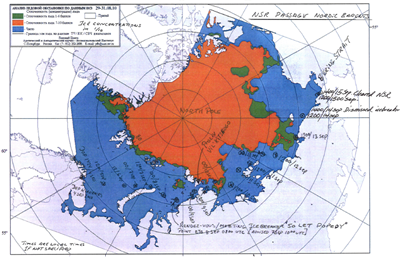Accelerated melting of ice in the Arctic has opened up some interesting sea routes which until recently used to be inaccessible for marine traffic due to severe ice conditions. The length of ice free season along the shipping routes in the Arctic is expected to increase considerably in coming years. These new trade links shortening the distance between the continents and in particularly the Northeast Passage, more commonly known as the Northern Sea Route, are becoming more accessible. Maritime traffic in the Arctic is already considerable. Each Arctic season is marked by a new development. Presently, shipping in the Arctic is primarily based on i.e. shipping oil and minerals out of Arctic ports. However, it seems days are not far when transarctic voyages would be feasible on regular commercial terms.
The Northwest Passage, the legendary passage, a shortcut shipping route between the Atlantic and Pacific along the Canadian Arctic, is not new and known since Roald Amundsen successfully navigated the fabled sea in 1905 during his extraordinary expedition. The route has potential to cut the distance by 40% when compared to transit through the Panama Canal. However, the passage still remains ice bound and in terms of climate change, more ice is retreating on the Russian side of the Arctic.
The Northeast Passage, known by Russians as "The Northern Sea Route" (NSR) is the shipping lane between the Atlantic Ocean and Pacific Ocean along the Russian coast of Siberia and the Far East and runs through the Barents, Kara, Laptev, East Siberian and Chuck Chi seas. The NSR is not a linear route and exact routing or optimal course of ships depends on the ice condition and size of the ships. In fact, it is the entire corridor which lies north of the Russian Federation in the Arctic.

The Hong Kong Flagged Bulk Carrier (Ice Class 1-A) transited the Arctic in September 2010 (information source – Tschudi Shipping)
The NSR route has the potential of shortening the voyage distance by up to 50% when compared to transits through the Suez Canal.
Risks and challenges:
The Arctic presents some unique risks. Obstacles and challenges are manifold, including the following:
- Oil pollution management - the behaviour and persistence of spilled oil under arctic conditions would be quite different than what it would be in a temperate climate. Prevention, preparedness and response would be quite challenging
- Remoteness impacting rescue and emergency operations
- Lack of information about safe ports
- Insufficiently detailed charts with white spots
- Inadequately developed infrastructure and their implications on SAR
- Ice/winter related issues – ice accretion, ice damage, restricted visibility and multiple operational problems
- Limited knowledge of local oceanographic conditions
- Increased number of ice floes and icebergs during early melting season
- Lack of reliable weather and ice information and meteorological dataLimited knowledge of local oceanographic conditions
- Conventional gyro and magnetic compasses, communication equipment may not function at its optimum level in higher latitudes
- Unavailability of adequate number of ice trained and competent crew.
Oil Spill Response in the Arctic and Cold Climate
Behaviour and fate of spilled oil in the Arctic and cold climate would differ significantly when compared to temperate climate. The detection and tracking, containment and recovery of spilled oil in the adverse Arctic climate would be some of the major challenges faced by the industry.
The Association's arctic group is pleased to advise that ITOPF has provided technical advice on the response to oil spills in the Arctic. The advice can be accessed following the link.
The new law on NSR, adopted recently by the Russian legislators (entering into force in 2013), lays down regulations to administer NSR traffic. This includes:
- Compulsory insurance, thus enhancing shipowners' responsibility for possible pollution and other environmental damage
- Outlines the level of shipping fees
- Mandatory ice breaker service
- Carriage of ice pilot
- Formal authorisation procedure by the Northern Sea Route Administration
- Organise Search and Rescue operation
- Provide radio communication and hydrographic information.
Should members inform their insurers before undertaking an arctic voyage?
P&I: normally the club does not impose any trading limit for addressing arctic voyages for risks covered under worldwide policy. However, if the voyages in the Arctic do not fall under the vessel's normal trading pattern, the Association should be consulted for the following reasons:
a) Members are required to make correct and prompt disclosure to the association of every change in circumstances which alters the risk covered by the Association. Arctic voyages may significantly alter the risks
b) The Association can provide and/or share with the insured some relevant information and expertise in order to achieve the best outcome. Members can benefit from Skuld's resources based on experience of insuring significant ice class tonnage
c) The Association can assist members in evaluating and mitigating the Arctic risks.
Risks covered under hull policy
Members are advised to check the trading limits of their hull policies. Arctic voyages could be a risk excluded under hull policy trading limits. For example, International Navigating Limits (01/11/03) and Norwegian Marine Insurance Plan both constitute Arctic waters as an excluded area. it may therefore be essential to obtain underwriters' prior permission and to agree on any amended terms of cover, including increased deductible - also known as ice deductible, and any additional premium required by the Underwriters.
If members have any queries in this regard, they are advised to contact the Association for further assistance. The Association has expertise and continues to invest strategically in further development of guidelines for managing risks in the Arctic and cold climates.